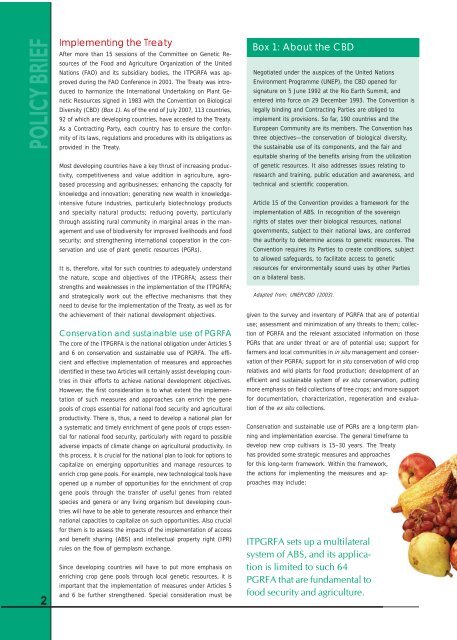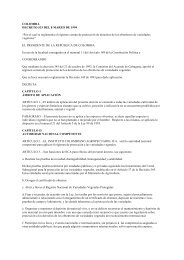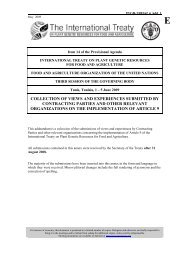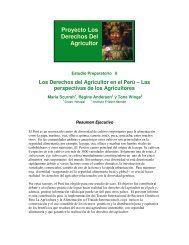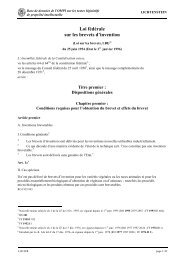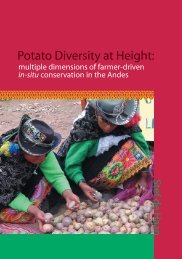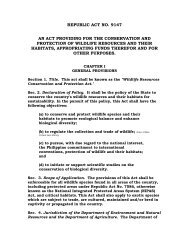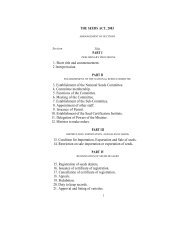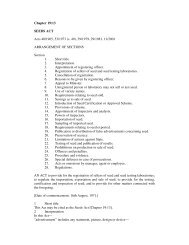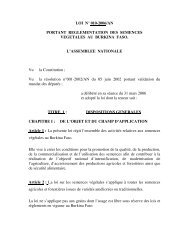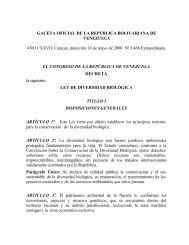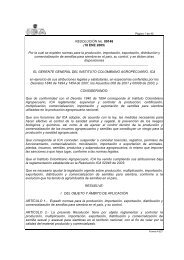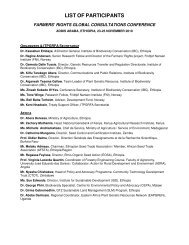itpgrfa - Farmers' Rights website
itpgrfa - Farmers' Rights website
itpgrfa - Farmers' Rights website
You also want an ePaper? Increase the reach of your titles
YUMPU automatically turns print PDFs into web optimized ePapers that Google loves.
2POLICY BRIEFImplementing the TreatyAfter more than 15 sessions of the Committee on Genetic Resourcesof the Food and Agriculture Organization of the UnitedNations (FAO) and its subsidiary bodies, the ITPGRFA was approvedduring the FAO Conference in 2001. The Treaty was introducedto harmonize the International Undertaking on Plant GeneticResources signed in 1983 with the Convention on BiologicalDiversity (CBD) (Box 1). As of the end of July 2007, 113 countries,92 of which are developing countries, have acceded to the Treaty.As a Contracting Party, each country has to ensure the conformityof its laws, regulations and procedures with its obligations asprovided in the Treaty.Most developing countries have a key thrust of increasing productivity,competitiveness and value addition in agriculture, agrobasedprocessing and agribusinesses; enhancing the capacity forknowledge and innovation; generating new wealth in knowledgeintensivefuture industries, particularly biotechnology productsand specialty natural products; reducing poverty, particularlythrough assisting rural community in marginal areas in the managementand use of biodiversity for improved livelihoods and foodsecurity; and strengthening international cooperation in the conservationand use of plant genetic resources (PGRs).It is, therefore, vital for such countries to adequately understandthe nature, scope and objectives of the ITPGRFA; assess theirstrengths and weaknesses in the implementation of the ITPGRFA;and strategically work out the effective mechanisms that theyneed to devise for the implementation of the Treaty, as well as forthe achievement of their national development objectives.Conservation and sustainable use of PGRFAThe core of the ITPGRFA is the national obligation under Articles 5and 6 on conservation and sustainable use of PGRFA. The efficientand effective implementation of measures and approachesidentified in these two Articles will certainly assist developing countriesin their efforts to achieve national development objectives.However, the first consideration is to what extent the implementationof such measures and approaches can enrich the genepools of crops essential for national food security and agriculturalproductivity. There is, thus, a need to develop a national plan fora systematic and timely enrichment of gene pools of crops essentialfor national food security, particularly with regard to possibleadverse impacts of climate change on agricultural productivity. Inthis process, it is crucial for the national plan to look for options tocapitalize on emerging opportunities and manage resources toenrich crop gene pools. For example, new technological tools haveopened up a number of opportunities for the enrichment of cropgene pools through the transfer of useful genes from relatedspecies and genera or any living organism but developing countrieswill have to be able to generate resources and enhance theirnational capacities to capitalize on such opportunities. Also crucialfor them is to assess the impacts of the implementation of accessand benefit sharing (ABS) and intellectual property right (IPR)rules on the flow of germplasm exchange.Since developing countries will have to put more emphasis onenriching crop gene pools through local genetic resources, it isimportant that the implementation of measures under Articles 5and 6 be further strengthened. Special consideration must beBox 1: About the CBDNegotiated under the auspices of the United NationsEnvironment Programme (UNEP), the CBD opened forsignature on 5 June 1992 at the Rio Earth Summit, andentered into force on 29 December 1993. The Convention islegally binding and Contracting Parties are obliged toimplement its provisions. So far, 190 countries and theEuropean Community are its members. The Convention hasthree objectives—the conservation of biological diversity,the sustainable use of its components, and the fair andequitable sharing of the benefits arising from the utilizationof genetic resources. It also addresses issues relating toresearch and training, public education and awareness, andtechnical and scientific cooperation.Article 15 of the Convention provides a framework for theimplementation of ABS. In recognition of the sovereignrights of states over their biological resources, nationalgovernments, subject to their national laws, are conferredthe authority to determine access to genetic resources. TheConvention requires its Parties to create conditions, subjectto allowed safeguards, to facilitate access to geneticresources for environmentally sound uses by other Partieson a bilateral basis.Adapted from: UNEP/CBD (2003).given to the survey and inventory of PGRFA that are of potentialuse; assessment and minimization of any threats to them; collectionof PGRFA and the relevant associated information on thosePGRs that are under threat or are of potential use; support forfarmers and local communities in in situ management and conservationof their PGRFA; support for in situ conservation of wild croprelatives and wild plants for food production; development of anefficient and sustainable system of ex situ conservation, puttingmore emphasis on field collections of tree crops; and more supportfor documentation, characterization, regeneration and evaluationof the ex situ collections.Conservation and sustainable use of PGRs are a long-term planningand implementation exercise. The general timeframe todevelop new crop cultivars is 15–30 years. The Treatyhas provided some strategic measures and approachesfor this long-term framework. Within the framework,the actions for implementing the measures and approachesmay include:ITPGRFA sets up a multilateralsystem of ABS, and its applicationis limited to such 64PGRFA that are fundamental tofood security and agriculture.


